Catamaran Literary Reader – Summer 2013
Color is what first struck me with Catamaran Literary Reader. A quick flip through the pages reveals not only the abundance of visual artwork, but also the vibrancy of their colors and movement. The cover is “Jump #5,” one oil painting among four in the issue by Sarah Bianco which depicts several people in different stages of a leap downward against a background of yellow, blue, and red. It’s hard to tell where they will land. I want to guess that the cover was chosen to match Catamaran’s emphasis on the “California regional themes of environmentalism, personal freedom, innovation, and artistic spirit.” For ages, people have come to California to live their dreams. For many, the move must have felt like a leap into a beautiful unknown.
Color is what first struck me with Catamaran Literary Reader. A quick flip through the pages reveals not only the abundance of visual artwork, but also the vibrancy of their colors and movement. The cover is “Jump #5,” one oil painting among four in the issue by Sarah Bianco which depicts several people in different stages of a leap downward against a background of yellow, blue, and red. It’s hard to tell where they will land. I want to guess that the cover was chosen to match Catamaran’s emphasis on the “California regional themes of environmentalism, personal freedom, innovation, and artistic spirit.” For ages, people have come to California to live their dreams. For many, the move must have felt like a leap into a beautiful unknown.
The work of the other visual artists featured in the issue is as gripping as Bianco’s Jump series. Philip Rosenthal’s lush birds and flowers in “Point,” “Fish,” and “Pollenized” are out of proportion, without depth or perspective, and seem to be arranged in particular geometric patterns. It’s as if the birds and flowers were paper cutouts pasted onto a board, giving them a look between life and death. The same is true of “Two Characters with Gilded Faces” and “Power Figure” by Ivan De MonBrison.” Both feature line drawings of two figures whose faces are splashed with yellow and a little red. Is the yellow a mark of life, holiness, death, or something else? A cormorant perches on the edge of a cliff in Michael Schlicting’s “Cormorant Cleft”: light shines into the cleft, but the cormorant stays a silhouette on the dark side of the picture. My heart stopped at Christopher Felver’s “London,” a black-and-white photographic collage of a silhouette of a naked person holding on to what looks like a horn jutting out of the top of a building. I can only imagine that he is swinging. Meanwhile, a plane passes in the sky. Defiance and loneliness bursts out of the image. The bus riders of Joe Ravetz’s photographs return us to a California that is by no means representative of the whole state, but certainly uniquely and recognizably Californian: urban, life-hardened faces, diverse, on the way to somewhere other than here.
The natural world looms large in much of Catamaran. Stephen Haddock chronicles his fascination with jellyfish in “The Other Jellyfish.” Descriptions of types of jellyfish, which read as if they were lifted from a science text, are inserted throughout, and they become unexpectedly poetic interludes in the text. On land, Trane DeVore leads us through the Sonoma County countryside of his childhood and the Japanese mythology of trees in “In the Depths of Groves.” In “Dance Music for Suicides,” John Straley is a masterful guide through the Alaskan landscape, seascape, and dreamscape of his hero, who busts into his ex-wife’s house for drugs and tries to commit suicide in his wedding tuxedo before getting scooped up by his son and mother and reporting to prison. It’s raw and funny, but the hero’s apparent reconciliation with his son and society feels a little sudden and thin.
Likewise, RCA O’Neal’s “What Lay Around the Bend” draws the reader in with fantastically precise descriptions—although the deliberate archaisms are distracting—but I wish I knew, after the child had made the acquaintance of the mysterious girl in the garden, what changed between them or at least what changed in him.
Patricia Smith’s “Slither” is sexy:
This is illegal in scattered America. Left flabbed pink arm
links negro languid one and bedazzled bodies mangle
and steam an urgent corkscrew. Breath splatters nick ripple.
We are loud and racial in Florence, where the dawn drips
thin orange and the clock dribbles Dalí. . . .
Pleasures pop like little fireworks throughout: “bedazzled bodies mangle,” “steam an urgent corkscrew,” “[b]reath splatters nick ripple.” Even though sometimes I wouldn’t be able to say exactly what is going on, I don’t care. The poem straddles the border between mystery and obscurity perfectly. It is sensual and friendly, and it seduces and disarms.
Like the vessel of its namesake, Catamaran invites the reader on board, carries her into the open, and puts her in contact with the world. It pulses with life.
[catamaranliteraryreader.com]





